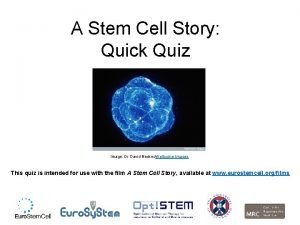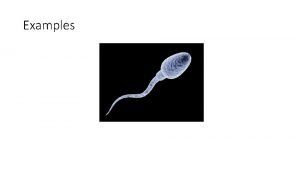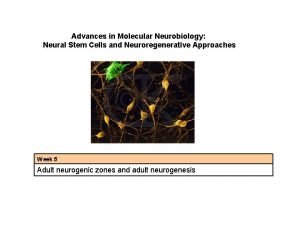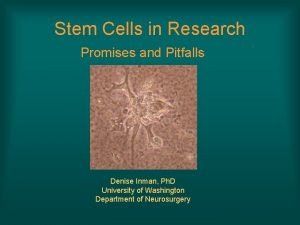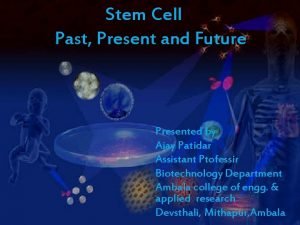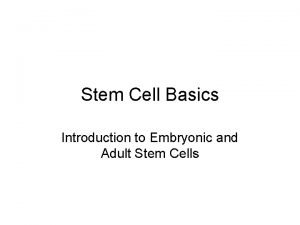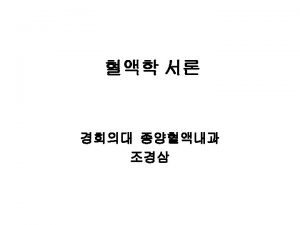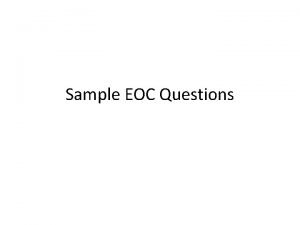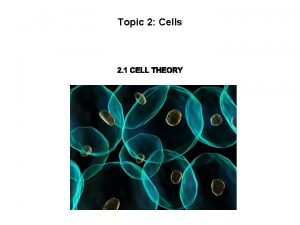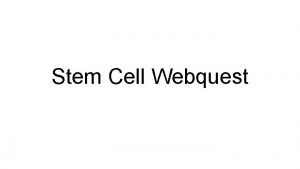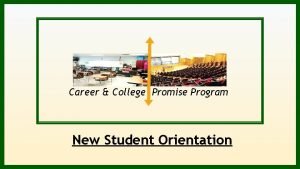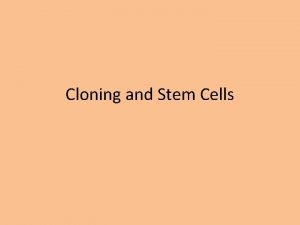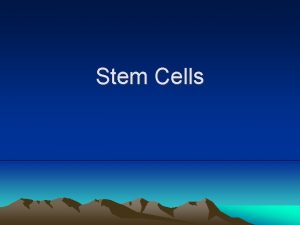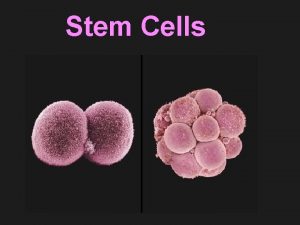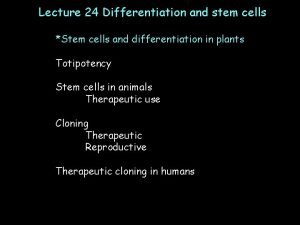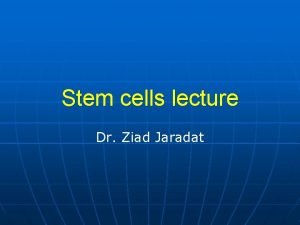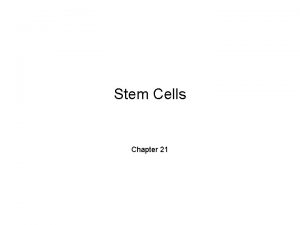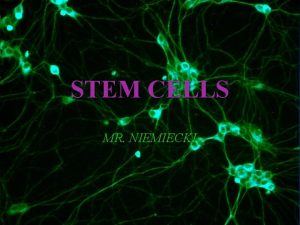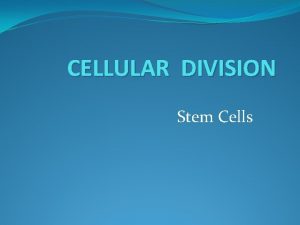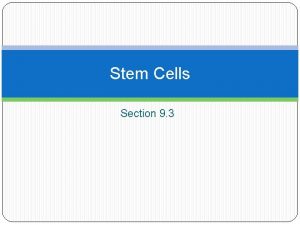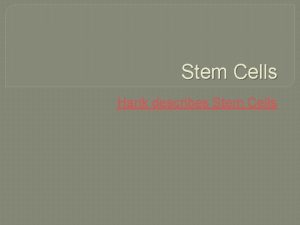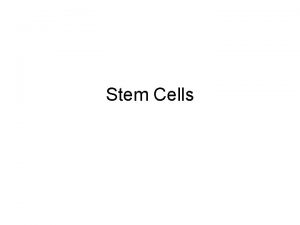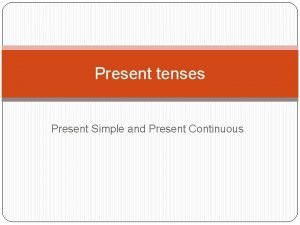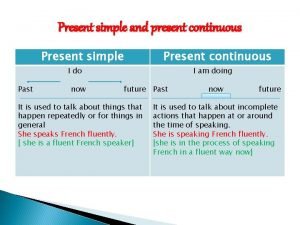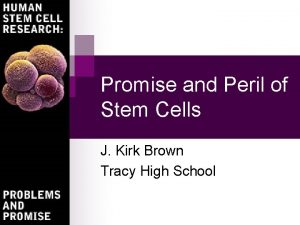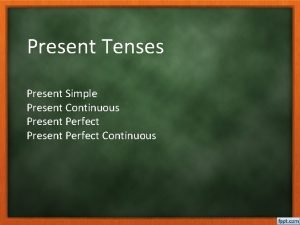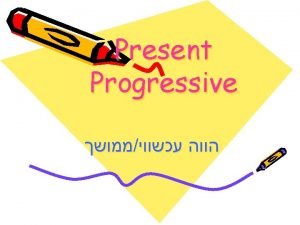Stem cells The present and the promise Tim































- Slides: 31

Stem cells: The present, and the promise. Tim Mc. Caffrey, Ph. D. Professor of Biochemistry and Molecular Biology Director, The Catherine Birch Mc. Cormick Genomics Center

Potential uses for stem cells Aging? Diabetes? Skin?

Making embryonic stem cells

Sources of stem cells

Uses for cord blood Malignant Diseases * Acute lymphocytic leukemia * Acute myelocytic leukemia * Juvenile chronic myelogenous leukemia * Chronic myelogenous leukemia * Neuroblastoma * Refractory anemia with blasts Nonmalignant Diseases * * * * * Fanconi anemia Aplastic anemia Refractory anemia Thalassemia Sickle cell anemia Amegakaryocytic thrombocytopenia Kostmann syndrome Blackfan-Diamond syndrome Severe combined immunodeficiency X-linked lymphoproliferative disorder Wiskott-Aldrich syndrome Hurler syndrome Hunter syndrome Gunther disease Osteopetrosis Globoid cell leukodystrophy Adrenoleukodystrophy Lesch-Nyhan syndrome

Marrow repopulation w/ stem cells

Causes of Death. United States. 1997. % of Deaths All causes 1 Diseases of heart 100. 0 31. 4 3 Cerebrovascular diseases 6. 9 15 Atherosclerosis 0. 7 Combined cardiovascular deaths--> 2 Malignant neoplasms (all cancers) 39. 0 23. 3 4 Chronic obstructive pulmonary diseases 4. 7 5 Accidents and adverse effects 4. 1 6 Pneumonia and influenza 3. 7 7 Diabetes mellitus 2. 7 8 Suicide 1. 3 14 Human immunodeficiency virus infection 0. 7 . . . All other causes. . . . National Vital Statistics Reports, Vol. 47, No. 19, June 30, 1999 15. 4

Age and Cardiovascular Disease • Source: World Health Organization Autopsy Study, 1976.

Efficacy of Angioplasty for Dilating Blockage Textbook of Medicine, 2 nd edition.

Surviving Myocardial Infarction Half of all myocardial infarctions are fatal. However, if ER care is available, mortality is less than 12%. Because of 1) angioplasty and 2) thrombolytics (t. PA, streptokinase) clot-busters 3) aspirin 4) aggressive and new anticoagulants More people are surviving MI.

MI and cardiomyocyte damage

Strategies for cardiac repair - Simple cardiomyoplasty - - reduce the dilation surgically - Angiogenic therapy - - induce new blood muscle formation - Laser-based reperfusion -- PMR/TMR - Cardiac regeneration --- IDEAL - Cardiac stem cell therapy --- the next best thing

Stem cell therapy- Goals • Restore blood flood to the ischemic region --> angiogenesis alone is not enough • Replace or regenerate fused and coupled cardiomyocytes • Prevent inflammatory process • Prevent fibroproliferative stiffening • Increase cardiac performance, thus, quality of life • Survival, survival

Types of stem cells tested Embryonic stem cells -cardiomyocyte progenitors (beating) Adult stem cells - skeletal muscle progenitors, satellite cells - hematopoetic stem cells (bone marrow derived) - mobilized hematopoetic stem cells (endogenous) - liver stem cells - mesenchymal stem cells

Embryoid body cardiomyocytes As few as several hundred embryonic stem cells will spontaneously aggregate. Within hours they will polarize and spontaneously contracting heart ‘beats’ are visible.

Problems with ES therapy • ethical issues of destroying human embryos • legal limitations prevent Federal funds to create new lines • probability of immune rejection is high • almost no ability to control their differentiation completely • possibility of teratocarcinoma is very real • viral and bacterial contamination of long-lived cultures (particularly with mouse feeder layer, bovine serum) • proven genetic deterioration of the cells • if you can’t sell Vioxx, how do you ‘sell’ cells?

Adult stem cells Advantages: - almost certainly no rejection issues - no destruction of embryonic/fetal tissues - should be plentiful and renewable - might allow identification of myogenic factor Disadvantages: - currently, yield is low, so ‘mobilization’ is used - possible introduction of neo-antigens - controlling differentiation is now minimal - ? ? ? Telomeric barriers ? ? ? - market uncertainty “Where’s the drug? ”

Biosense/NOGA (Cordis) GPS for the heart · Catheter tip is both an ECG electrode and a GPS antenae · Tip placement is controled by user under direction of computer mapping routine. · As new data points are gathered, the computer constructs a map from interpolation.

Voltage Map of the Left Ventricle 25 m. V Biosense can combine electrical activity with wall motion at each point. 5 m. V 1. 0 cm

NOGA-based delivery of stem cells

Satellite cell cardiomyoplasty (Blue nuclei = host heart; Red = donor skeletal satellite cells)

SPECT and NOGA Before After Reversible Irreversible Injection Sites 2 months post-op 15 injections of auto. bone marrow monocytes

Questions for stem cell therapy • Is the damaging factor (virus, autoimmunity) gone? • What is the right replacement cell (s)? • What is right timing for transplantation? • How to keep the cells at the infarct site? • Will healthy cells prevent disease progression? • Will healthy myocytes couple and entrain? • BIG QUESTION: Where are the cells? • BIGGER QUESTION: Will it work in old people?

Real-time imaging of fluorescently tagged cells Meta. Mouse: epifluorescent cell detection


New Options for Producing Embryonic Stem Cells • Non-destructive sampling of blastocysts. • Identify non-viable blastocysts for ES production. • “Retrodifferentiation” of adult cells to stem cells.

Blastomere-derived ES cells. Production of ES lines without destroying embryos. From Klimanskaya, Lanza (Advanced Cell Technologies) Nature. 2006 Jan 12; 439(7073): 216 -9.

Full differentiation of blast-ES Blast ES implanted into kidney capsule of immunodeficient mouse. Neural (ectodermal) Smooth muscle (mesodermal) Intestinal (endodermal) From Klimanskaya, Lanza (Advanced Cell Technologies) Nature. 2006 Jan 12; 439(7073): 216 -9.

ES cells from stalled fertilizations Naturally dead embryos yield stem cells--'Stalled' embryos could be new source of cell lines. Stojkovic et al. Stem Cells: Published online: 21 September 2006; Of 13 embryos naturally arrested at 6 -7 post-fertilization, 1 embryonic stem cell line could be established.

Summary: • Both embryonic and adult stem cells have limitless scientific potential. • Adult stem cells probably have greater immediate therapeutic value. • Embryonic stem cells probably can be created without destroying viable embryos. • Therapeutically, probably stem-cell derived factors will be used to promote tissue regeneration from resident stem cells.

 Paranasal sinuses development
Paranasal sinuses development Chlorocruorin
Chlorocruorin Animal cell venn diagram
Animal cell venn diagram Masses of cells form and steal nutrients from healthy cells
Masses of cells form and steal nutrients from healthy cells Where can scientists obtain stem cells? *
Where can scientists obtain stem cells? * Pluripotent stem cells examples
Pluripotent stem cells examples Stem cells
Stem cells Conclusion of stem cells
Conclusion of stem cells Conclusion of stem cells
Conclusion of stem cells Precursor cells
Precursor cells Stem cell classification chart
Stem cell classification chart Biochemistry questions
Biochemistry questions Outline one therapeutic use of stem cells
Outline one therapeutic use of stem cells Stem cells webquest
Stem cells webquest Stem cells specialization
Stem cells specialization Alpha intercalated cell
Alpha intercalated cell Thyroid gland
Thyroid gland Gametes vs somatic cells
Gametes vs somatic cells Somatic vs germ cells
Somatic vs germ cells Eukaryotic life
Eukaryotic life Prokaryotic cells
Prokaryotic cells The organelle trail
The organelle trail Label
Label What animals have prokaryotic cells
What animals have prokaryotic cells Prokaryotic vs eukaryotic cells
Prokaryotic vs eukaryotic cells Chapter 8 cellular reproduction cells from cells
Chapter 8 cellular reproduction cells from cells Cell substance
Cell substance Present simple present continuous and present perfect
Present simple present continuous and present perfect Girl scout promise and law
Girl scout promise and law Cpcc student id
Cpcc student id I write a letter now past continuous tense
I write a letter now past continuous tense Difference present perfect simple and continuous
Difference present perfect simple and continuous




